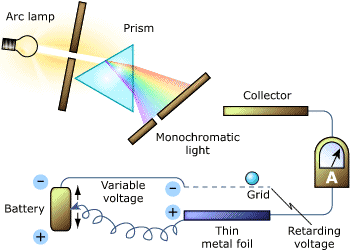| Waves or Particles? 1:6 | Waves or Particles? 2:6 » | |
| Waves or Particles? 1:6 | Waves or Particles? 2:6 » | |
Waves or Particles?The Photoelectric Effect |
||||
While Planck was struggling with the Black body problem in 1899 another German physicist, Philipp Lenard, was illuminating thin metal foils with light in order to produce 'cathode rays' (which would soon be identified as electrons). This had been observed by Hertz 10 years earlier, but Lenard designed a far better experiment where a simple electrical circuit was used to determine the properties of the cathode rays. The energy of the electrons emitted from the thin metal foil could be gauged by varying the retarding voltage. When a sufficiently negative voltage is set on the grid (a fine wire mesh) the electrons will not make it to the collector as they are completely repelled by the negatively charged grid. Lenard made a very surprising discovery: the intensity of the light had no effect on the energy of the ejected electrons. Moreover, experiments showed that there was a threshold frequency below, which not a single photoelectron was ejected. Below this frequency, the brightness of the incident light made no difference at all! Classical physics had failed again – it could not explain either of these observations and Lenard won the Nobel Prize in Physics in 1905. |
 |
Electrons are emitted from a metal foil when it is bombarded with photons above a certain frequency.
|
Related Laureates |
||